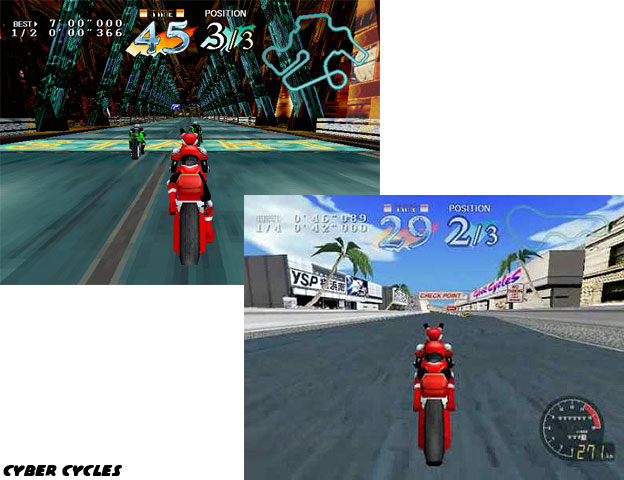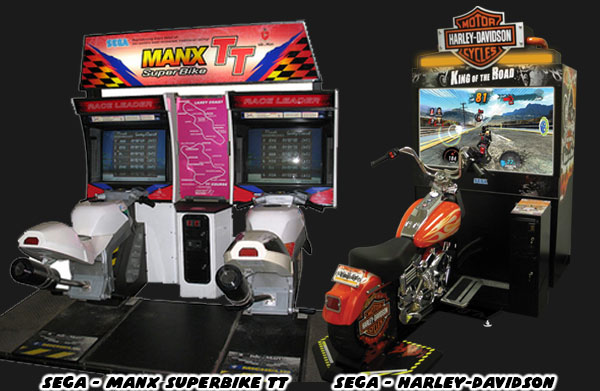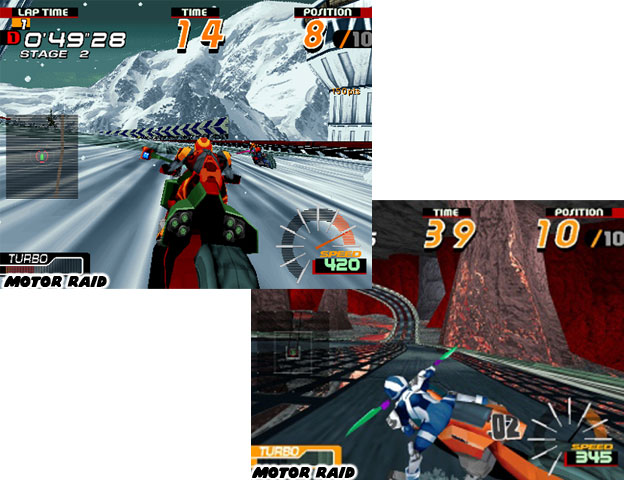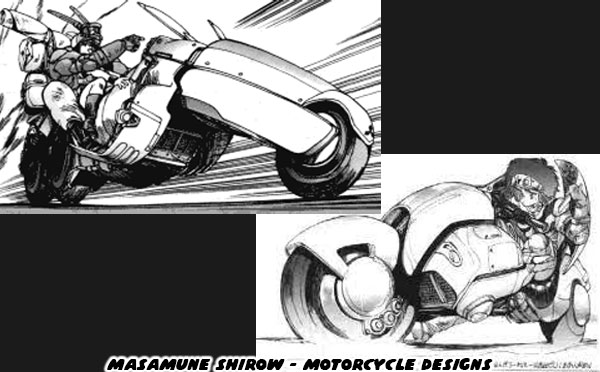Namco decided to dress up their fighting game character Paul Phoenix in leather motorcycle gear and have him ride around in a big custom bike in the game endings and official game art. These changes were made to make the character appear less generic and less like a clone of Ken from Street Fighter. It was also one of the early jabs that the studio took at Sega. The designers at Namco noticed that if Sega were going to link the Virtua Fighter star Jacky to their racing legacy then they would begin putting Phoenix and the other Tekken fighters in other titles as well. Since Jacky was a poster boy for Sega's auto racing lineage then Namco decided to put Phoenix on a motorcycle. After all bikes were supposed to be much cooler than cars and no motorcycle shouted America louder than a flame painted Harley Davidson. Or at the very least a Harley Davidson knock-off.

Cyber Cycles was a motorcycle racing game that Namco released in 1995. It was out about the same time as Virtual-On and Cyber Commando. Since science fiction design was working very well in the early 3D titles and even contemporary racing titles were given locations and vehicles that were ahead of the curve. There were three classes of motorcycles featured in Cyber Cycles. The easiest to control had the slowest top speed. The fastest in the game was the most difficult to control and of course there was a bike in the middle that was easy to control and had a good top speed. The easy and medium class bikes looked like Japanese or Italian racing motorcycles however the difficult one with the biggest engine looked like a classic American chopper.
To give the appearance of multiple characters in the game each bike had four possible colors. The riders in the title never took off their helmets but the designs on the back of their jackets were different. The rider on the blue chopper had an orca on the back of his, the one with the yellow had a cow skull and the one in red had a pin up girl. The one in black had a skull and swords logo as well as flame designs on his pants. The character and his livery were identical to Paul Phoenix and his Wild Hog custom bike which had debuted just a few months earlier. Without naming the character Namco had put one over on Sega.

Arcade visitors had by and large become addicted to fighting games thanks to the smash hit Street Fighter II in 1991. In just a few short years every major developer, and even dozens of unknown developers had released a fighting game of their own. Sega and Namco had raised the bar by moving the genre into 3D. In 1995 Tekken 2 was arguably the hottest thing in the arcades and the designers at Namco knew how to capitalize on its success. Although there were many different teams working internally, just as there were at Sega, they saw the potential for cross pollination early on. The team working on Cyber Cycles did not need to name Phoenix in game or make an exact replica of the Wild Hog but audiences that might not have normally played a motorcycle game found sudden interest in it.

Sega actually had a reply waiting for Namco. The studio had Manx TT out in arcades in 1995 as well. The Sega game appeared superior visually to the Namco game and controlled as well if not better. Sega's title was based on the actual Isle of Man superbike race. Which was one of the most thrilling and dangerous courses in the world. However despite the awesome efforts of AM3 many arcade players slept on the title. Of the two big racing games released that year the cameo from Paul Phoenix took Namco over the top. The next motorcycle game from Sega would completely break all conventions. The studio licensed the actual Harley Davidson name and set a 1998 game on an open world map based in Los Angeles. The game Harley Davidson and L.A. Riders had players racing through random checkpoints all over the city. The game handled far more realistically than Cyber Cycles and I would have to say that I saw more arcades with L.A. Riders cabinets than Cyber Cycle ones. Yet that same year they released something that was so wild that audiences had a hard time describing it.

Motor Raid was a tournament combat racing game set in the far future and across several alien planets. The title could only barely be considered a motorcycle racing game. It did indeed feature two-wheeled vehicles, a circuit and a countdown clock like previous racers. The settings, locations, gravity defying tracks and ability to fight opponents however made it more like a vehicle combat game, a nonstop rolling version of Twisted Metal in the far flung future. Motor Raid was visually stunning. Sega plucked science fiction ideas and designs from a who's-who of anime titles including Akira and Venus Wars. Those films had amazing motorcycle sequences and respective designs from the visionary Katsuhiro Otomo and Yoshikazu Yasuhiko. The motorcycles were dangerous but refined, not unike
the weapon designs of Masamune Shirow. They featured a perfect blend of hard features and soft curves. The racers themselves wore armor which mirrored the type of motorcycle they took into battle.

The only real competition that Sega faced in the arcade was from Namco. Both studios were constantly pushing the uses of 3D engines in game development. Every genre that they applied the new architecture to was a major milestone for the industry. The polygon was make or break technology for other studios but between Namco and Sega it would be a jumping off point for every battle. The racing genre would be the subject of the biggest war between the two companies. The next blog will look at where Namco seemingly took the lead.
As always if you would like to sponsor me
please visit my Patreon page and consider donating each month, even as little as $1 would help make better blogs and even podcasts!





Indifferent I really did not play much of the motorcycle games after Hang-On so I was pretty foggy on the character appearances from both franchises.
ReplyDelete